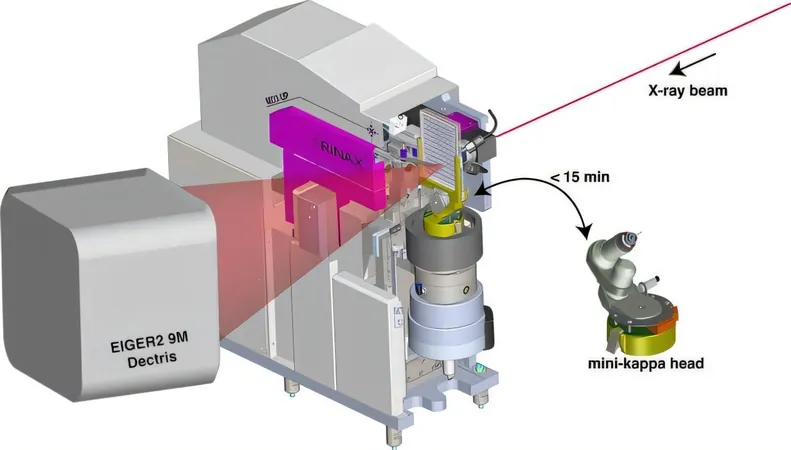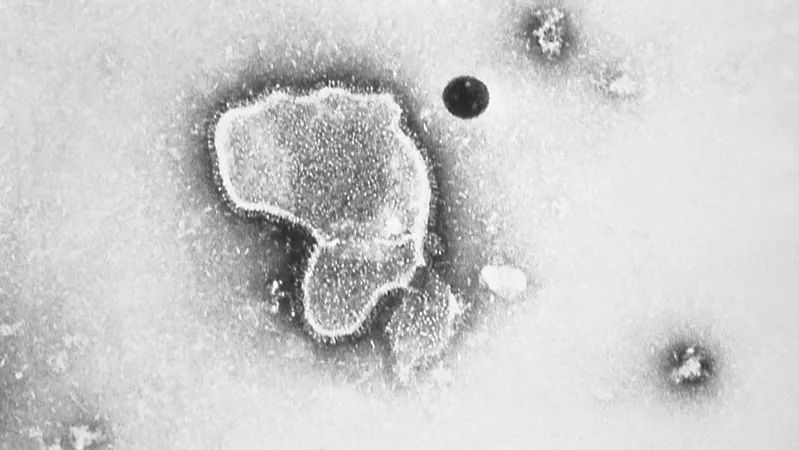
Revolutionizing Structural Biology: A Breakthrough in In Situ Serial Crystallography
2024-11-12
Author: Amelia
Revolutionizing Structural Biology: A Breakthrough in In Situ Serial Crystallography
Scientists at the European Molecular Biology Laboratory (EMBL) in Grenoble and the European Synchrotron Radiation Facility (ESRF) have unveiled a groundbreaking method that could dramatically simplify and enhance the process of studying the structure of macromolecules through in situ serial crystallography (iSX). This innovative technique, recently detailed in the journal IUCrJ, is now fully operational at the ID23-2 beamline, a collaborative project between EMBL and ESRF.
Nicolas Foos, the pioneering author of this study, has an impressive background that includes a Ph.D. in biochemistry and molecular biology from the Université de Marseille, and postdoctoral research at renowned synchrotrons like SOLEIL and ESRF. Joining the McCarthy team at EMBL Grenoble in 2021 as part of the ARISE program, Foos is committed to advancing the frontiers of macromolecular crystallography.
The Game-Changing Features of In Situ Serial Crystallography
The distinctive aspect of this new method is its ability to operate directly from the crystallization plate, eliminating the painstaking process of harvesting crystals, which typically involves selecting just a few from an average of 96 wells. Instead, researchers can now screen and gather data directly from the crystallization plate itself, significantly reducing time and effort.
Utilizing state-of-the-art micro-diffractometers paired with specialized plate holders designed for SBS-96 plates, this method achieves exceptional data collection accuracy. Such high-performance tools are critical for generating reliable structural data.
Moreover, the development of an intuitive user interface tailored to researchers enhances the usability of this sophisticated equipment, enabling users to maximize their experimental efficiency and precision.
Major Advantages for Structural Biology and Drug Discovery
This new method presents numerous advantages for structural biology. By streamlining the structure determination workflow, it not only shortens project timelines but also cuts costs—an essential factor for teams tackling complex research endeavors. Additionally, this approach is set to revolutionize drug discovery by allowing the screening of compounds directly in the crystallization plates at room temperature. This flexibility is vital for studying biological targets in their natural, dynamic state, leading to higher quality and more reliable results.
Looking to the future, Foos expressed excitement about the potential for fully automated workflows in the near term. Envision a seamless "From the plate to the 3D model" pipeline with minimal human intervention—an ultimate goal that could redefine how researchers operate in the field of structural biology.
The ARISE Fellowship: A Catalyst for Accessible Crystallography
Foos’s aspiration in joining the ARISE fellowship was clear: to democratize access to crystallography for a broader range of scientists, including those without extensive expertise. He hopes to see X-ray crystallography become a staple in the toolkit of integrative biology.
Reflecting on his experiences within the ARISE program, Foos praised its robust training structure. From the moment applicants begin their journey, they are required to meticulously outline every detail of their proposed projects, fostering a comprehensive understanding of the scientific and technical challenges at hand.
A standout feature of the ARISE program is its unique secondment requirement. It allows fellows to collaborate with diverse organizations and teams, enriching their experience. During his fellowship, Foos worked closely with both ESRF and ARINAX, a company that markets EMBL Grenoble’s instrument prototypes globally, as well as ALPX, which provides vital crystallography services to the pharmaceutical and biotech sectors.
ARISE is an exceptional opportunity for multidisciplinary innovators like Foos, who thrive where science intersects with technology. The program bridges academic research and industry, creating pathways for collaboration and innovation that empower the next generation of scientific breakthroughs.
Final Thoughts
With the introduction of this innovative iSX method and the invaluable support provided by the ARISE fellowship, the future of structural biology looks promising. As labs become increasingly equipped to explore macromolecular structures, we may soon witness a new era in biochemistry and drug discovery—one that is accessible to a wider audience of scientists eager to push the boundaries of knowledge.
Stay tuned as we continue to cover developments in this exciting field, which holds the promise of transformative discoveries in health and medicine!









 Brasil (PT)
Brasil (PT)
 Canada (EN)
Canada (EN)
 Chile (ES)
Chile (ES)
 España (ES)
España (ES)
 France (FR)
France (FR)
 Hong Kong (EN)
Hong Kong (EN)
 Italia (IT)
Italia (IT)
 日本 (JA)
日本 (JA)
 Magyarország (HU)
Magyarország (HU)
 Norge (NO)
Norge (NO)
 Polska (PL)
Polska (PL)
 Schweiz (DE)
Schweiz (DE)
 Singapore (EN)
Singapore (EN)
 Sverige (SV)
Sverige (SV)
 Suomi (FI)
Suomi (FI)
 Türkiye (TR)
Türkiye (TR)